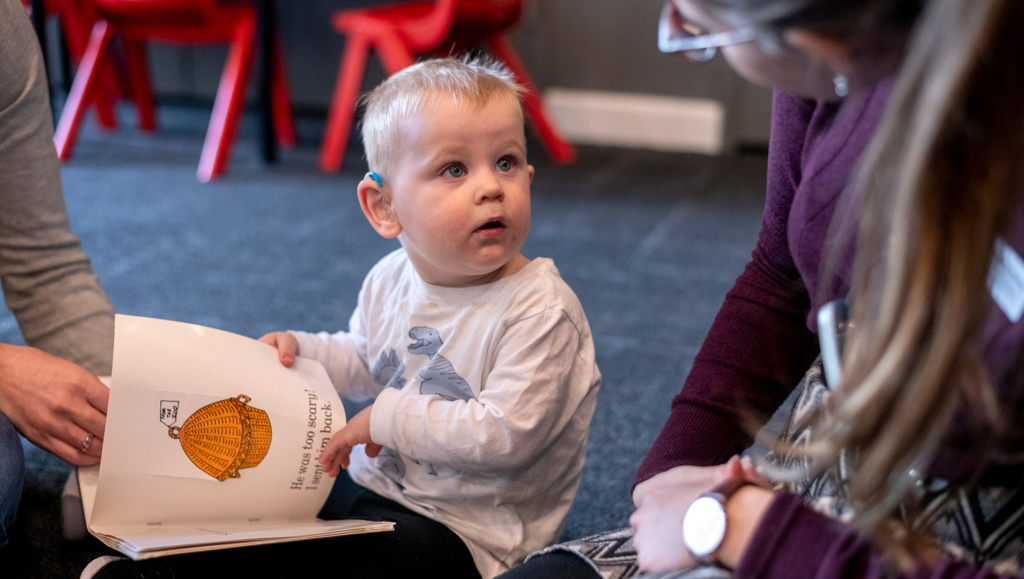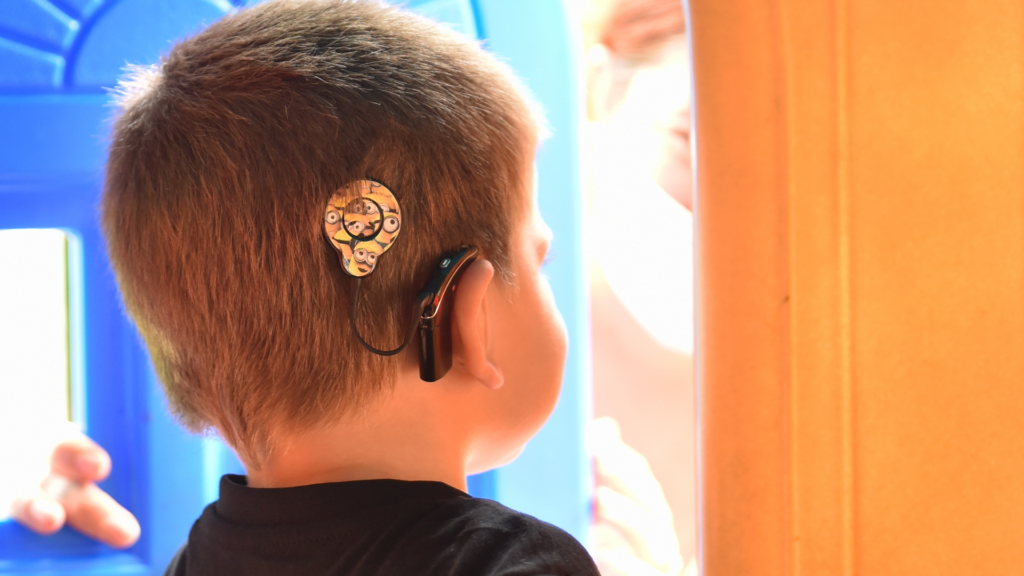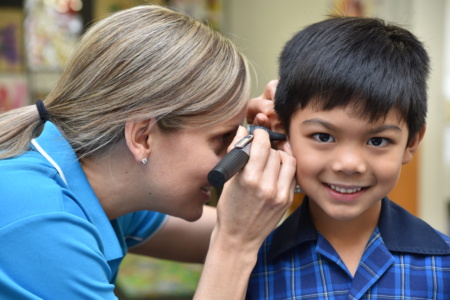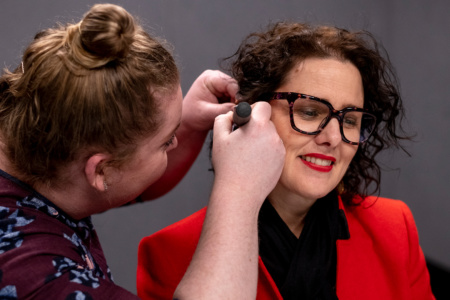An audiogram is a graph that displays the results of a hearing test. It shows the softest sounds someone can hear at different pitches (low, mid, and high frequency sounds), including those required to hear and understand speech (the major speech frequencies). Where the results fall on the audiogram reflects how loud a sound must be for someone to hear it and which speech and environmental sounds can be heard and not heard at their normal volume.
If you or someone you know has had their hearing tested, you might have seen a chart like this:
How is an audiogram done?
The type of hearing test depends on the person's age and abilities. Sounds are played through the speaker, headphones, ear plugs, or headband in a quiet listening environment. The person must indicate that they have heard it in some way - options includes pushing a button, raising a hand, playing a piece in a game, or turning their head to a puppet. The volume of the sound is changed until the softest sound is determined. This is called a hearing threshold. Then different pitches are tested. Adults and older children are tested on six to eight pitches while young children complete four pitches.
Typically, the right ear and left ear is tested separately. When working with young children, sometimes the ears are tested together as they are unable to wear headphones or ear plugs
Air Conduction Testing – Testing starts by measuring the whole ear system working together, via the speakers, headphones, or ear plugs. This is called an air conduction test, because the sound travels through the air, via the ear canal, ear drum, and middle ear bones.
Bone Conduction Testing – If a hearing loss is found, then testing aims to identify what part of the ear is not working. A vibrating box on a headband is used. This is called a bone conduction test because the sound travels through the bones of the skull, directly to the hearing organ or cochlea.
When the sound is played loud enough, both cochleae will hear it, regardless which ear is being tested, as they are close together in the skull. Therefore, whooshing or rain sounds will be play into one ear to distract it while the other ear is tested. This is called masking.
The ability to hear speech is then assessed. The person is asked to point to pictures or repeat words or sentences. This tell us how well a person can hear and understand speech to see how much a hearing loss is impacting a person’s communication.

What are the different types of hearing loss an audiogram will measure?
An audiogram will help identify not only if someone has a hearing loss, but the type of hearing loss they have. Knowing the degrees of hearing loss, which ear or ears the hearing loss affects, and if the hearing loss is conductive, sensorineural or mixed helps inform what treatment options are best.
Conductive hearing loss
Conductive hearing loss occurs when sound is unable to travel through the outer or middle ear. This could be due to earwax or a foreign object blocking the ear canal, a ruptured ear drum, fluid or infection in the middle ear space, or damage to the middle ear bones. Often conductive losses are temporary and will resolve when the obstruction is removed, the ear drum heals, or the middle ear fluid clears. This can require medical treatment. Some conductive hearing losses are permanent, so it is important to recheck hearing after any medical treatment.
Sensorineural hearing loss
Sensorineural hearing loss occurs when the cochlea cannot detect sound and/or send it via the hearing nerve to the brain. It is often due to the hair cells in the cochlea being absent or damaged. This can be due to an inherited genetic condition, excessive noise exposure, aging, injury, or disease. Sensorineural hearing losses are often permanent.
Mixed hearing loss
Mixed hearing loss is a combination of both conductive and sensorineural hearing loss. In these cases, there is damage to both the outer/middle and inner ear/cochlea.
How long does an audiogram take?
This depends on the person's age and hearing ability. A full hearing test can take between 40 to 90 minutes. This will likely be longer if a hearing loss is found. This includes about questions about your hearing concerns, hearing history, and general health or lifestyle. It is important to mention any previous ear infections/surgeries, if you experience any dizziness/balance issues, if you have seen an Ear, Nose, and Throat Specialist (ENT), or if you have a family history of hearing loss (particularly if it is permanent or acquired from a young age). Parents will also be asked if their child passed their newborn hearing screening and about their speech and language development.

How do you read an audiogram?
The horizontal axis of the audiogram represents the sound’s pitch or frequency range, ranging from 250 to 12,000 hertz (Hz). Most speech is within 250 to 6,000Hz. Vowels are typically low pitch while consonant are typically mid or high pitch. Soft high pitch sounds such as ‘s’, ‘f’, ‘th’ and ‘t’ are often the most difficult to hear because high frequency hearing losses are most common.
The vertical axis shows the sound’s loudness or volume, ranging from -10 to 120 decibels (dB). The closer to the top your results are, the better you can hear sounds.
Each ear is recorded as a separate line on a chart called your audiogram. A blue cross symbol is your left ear and the red circle symbol is your right ear. A black box or ‘s’ symbol shows how a child hears when listening with both ears together. Air conduction results and bone conduction results are also marked separately.
Any sounds below the line can be heard while any sounds above the line cannot be heard.
What does normal hearing look like on an audiogram?
Normal hearing for children and adults is between -10 and 20dB.
A hearing loss occurs when hearing is at 25dB or greater. The severity of a hearing loss is determined by how loud sounds must be for them to be heard. The severity of hearing loss may change between different pitches and between each ear.
- Mild hearing loss = 25-40dB
- Moderate hearing loss = 45-65dB
- Severe hearing loss = 70-85dB
- Profound hearing loss = 90dB or greater


Who should get an audiogram?
If you are worried about your hearing or suspect you have a hearing loss, a hearing test is recommended. Here are some common symptoms of hearing loss:
- Missing what people say.
- Asking people to repeat themselves.
- Asking people to speak clearer or stop mumbling.
- A ringing or buzzing in your ears (tinnitus).
- Difficulties following conversations.
- Difficulties talking on the phone.
- Turning up the volume on the TV or radio.
- Difficulties hearing people when it is noisy, for example in a restaurant or at the shops.
- Using lots of effort when listening or finding listening tiring.
Children may also show delays in their speech and language development.
What’s next?
Following a hearing test, the audiologist will talk through the hearing test results, including if there is a hearing loss.
If there is a hearing loss, a treatment plan will be discussed. This may include watchful waiting, further/repeat testing, seeing an Ear, Nose, and Throat Specialist (ENT), using communication strategies, trialing hearing aids, or considering a cochlear implant.
For people who require hearing aids, the audiologist will use the audiogram results to determine how to program the hearing aids so that the person can hear clearly.
Hear and Say provides an array of audiology services for people of all ages, including comprehensive hearing tests, hearing aid fitting and management, tinnitus assessments, and hearing/cochlear implant services.
Find out more or book your hearing test today.
Contact us








